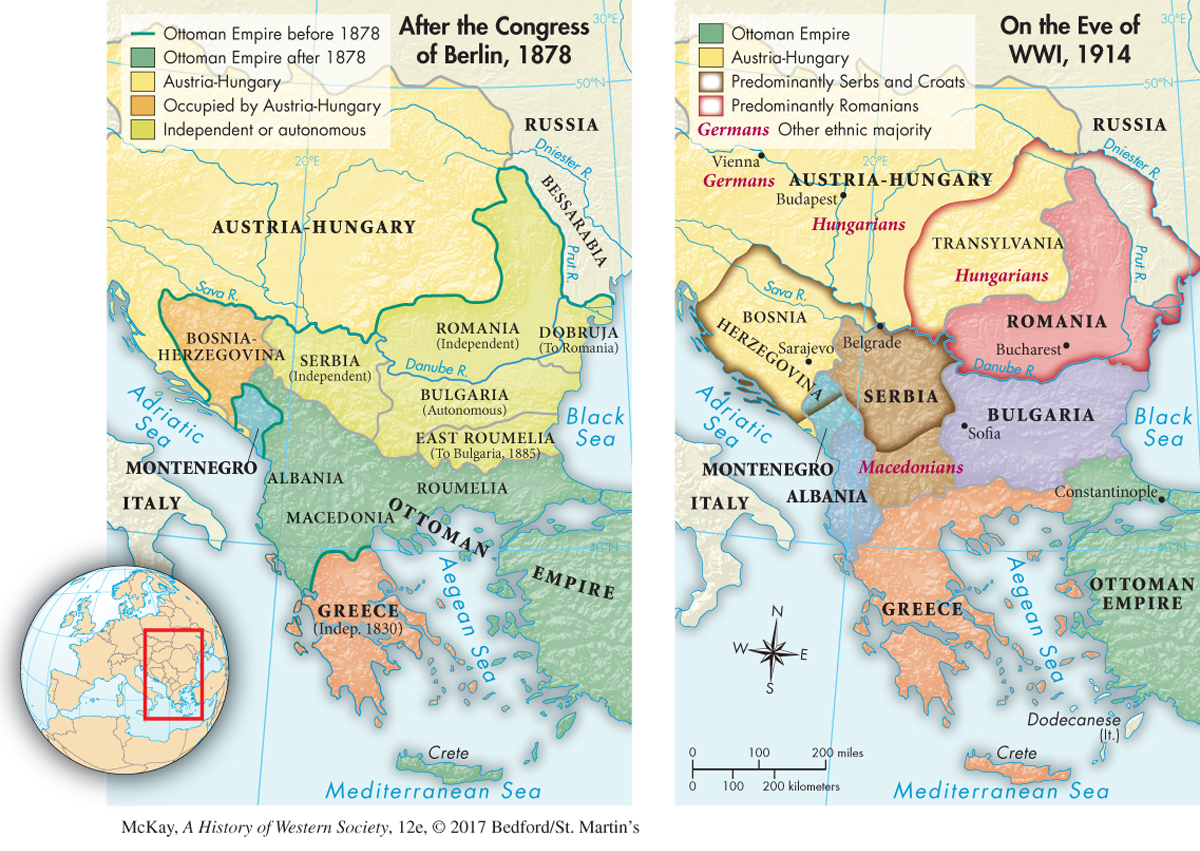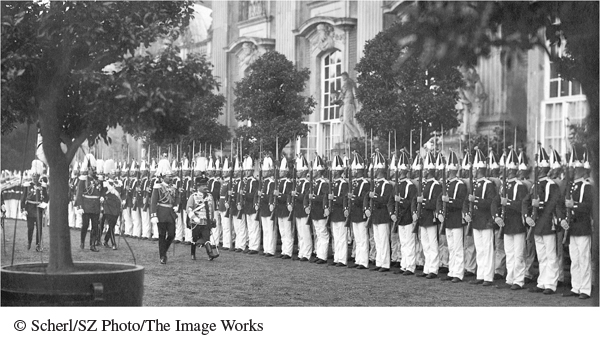The Outbreak of War
On June 28, 1914, Archduke Franz Ferdinand, heir to the Austro-Hungarian throne, was assassinated by Serbian revolutionaries during a state visit to the Bosnian capital of Sarajevo (sar-uh-YAY-voh). After a series of failed attempts to bomb the archduke’s motorcade, Gavrilo Princip, a fanatical member of the radical group the Black Hand, shot the archduke and his wife, Sophie, in their automobile. After his capture, Princip remained defiant, asserting at his trial, “I am a Yugoslav nationalist, aiming for the unification of all Yugoslavs, and I do not care what form of state, but it must be free from Austria.”4
Princip’s deed, in the crisis-ridden borderlands between the weakened Ottoman and Austro-Hungarian Empires, led Europe into world war. In the early years of the twentieth century, war in the Balkans — “the powder keg of Europe” — seemed inevitable. The reason was simple: between 1900 and 1914 the Western powers had successfully forced the Ottoman rulers to give up their European territories. Serbs, Bulgarians, Albanians, and others now sought to establish independent nation-states, and the ethnic nationalism inspired by these changing state boundaries was destroying the Ottoman Empire and threatening Austria-Hungary (Map 25.2). The only questions were what kinds of wars would result and where they would lead.

Figure 25.2: MAP 25.2 The Balkans, 1878–1914 After the Congress of Berlin in 1878, the Ottoman Empire suffered large territorial losses but remained a power in the Balkans. By 1914 Ottoman control had given way to ethnic population groups that flowed across political boundaries, and growing Serbian national aspirations threatened Austria-Hungary.
By the early twentieth century nationalism in southeastern Europe was on the rise. Independent Serbia was eager to build a state that would include all ethnic Serbs and was thus openly hostile to Austria-Hungary and the Ottoman Empire, since both states included substantial Serbian minorities within their borders. To block Serbian expansion, Austria in 1908 annexed the territories of Bosnia and Herzegovina (hehrt-suh-goh-VEE-nuh). The southern part of the Austro-Hungarian Empire now included an even larger Serbian population. Serbians expressed rage but could do nothing without support from Russia, their traditional ally.

German Militarism The German emperor Wilhelm II reviews his troops with the Italian king Victor Emmanuel in front of the royal palace in Potsdam in 1902. Aggressive militarism and popular nationalism helped pave the road to war.
(© Scherl/SZ Photo/The Image Works)
The tensions in the Balkans soon erupted into regional warfare. In the First Balkan War (1912), Serbia joined Greece and Bulgaria to attack the Ottoman Empire and then quarreled with Bulgaria over the spoils of victory. In the Second Balkan War (1913), Bulgaria attacked its former allies. Austria intervened and forced Serbia to give up Albania. After centuries, nationalism had finally destroyed the Ottoman Empire in Europe. Encouraged by their success against the Ottomans, Balkan nationalists increased their demands for freedom from Austria-Hungary, dismaying the leaders of that multinational empire.
Within this complex context, the assassination of Archduke Franz Ferdinand instigated a five-week period of intense diplomatic activity that culminated in world war. The leaders of Austria-Hungary concluded that Serbia was implicated in the assassination and deserved severe punishment. On July 23 Austria-Hungary gave Serbia an unconditional ultimatum that would violate Serbian sovereignty. When Serbia replied moderately but evasively, Austria mobilized its armies and declared war on Serbia on July 28. In this way, multinational Austria-Hungary, desperate to save its empire, deliberately chose war to stem the rising tide of hostile nationalism within its borders.
From the beginning of the crisis, Germany encouraged Austria-Hungary to confront Serbia and thus bore responsibility for turning a little war into a world war. Emperor Wilhelm II and his chancellor Theobald von Bethmann-Hollweg realized that war between Austria and Russia was likely, for a resurgent Russia would not stand by and watch the Austrians crush the Serbs, who were Russia’s traditional allies. Yet Bethmann-Hollweg hoped that, although Russia (and its ally France) would go to war, Great Britain would remain neutral, unwilling to fight in the distant Balkans. With that hope, the German chancellor sent a telegram to Austria-Hungary, which promised that Germany would “faithfully stand by” its ally in case of war. This “blank check” of unconditional support encouraged the prowar faction in Vienna to take a hard line against the Serbs at a time when moderation might still have limited the crisis.

The Schlieffen Plan
The diplomatic situation quickly spiraled out of control as military plans and timetables began to dictate policy. Vast Russia required much more time to mobilize its armies than did Germany and Austria-Hungary. And since the complicated mobilization plans of the Russian general staff assumed a two-front war with both Austria and Germany, Russia could not mobilize against one without mobilizing against the other. Therefore, on July 29 Tsar Nicholas II ordered full mobilization, which in effect declared war on both Austria-Hungary and Germany. The German general staff had also long thought in terms of a two-front war. Their misguided Schlieffen Plan called for a quick victory over France after a lightning attack through neutral Belgium — the quickest way to reach Paris — before turning on Russia. On August 3 German armies invaded Belgium. Great Britain, infuriated by the German violation of Belgian neutrality, declared war on Germany the following day.
The speed of the so-called July Crisis created shock, panic, and excitement, and a bellicose public helped propel Europe into war. In the final days of July and the first few days of August, massive crowds thronged the streets of Paris, London, St. Petersburg, Berlin, and Vienna. Shouting prowar slogans, the enthusiastic crowds pushed politicians and military leaders toward the increasingly inevitable confrontation. Events proceeded rapidly, and those who opposed the war could do little to prevent its arrival. In a little over a month, a limited Austrian-Serbian war had become a European-wide conflict, and the First World War had begun.


